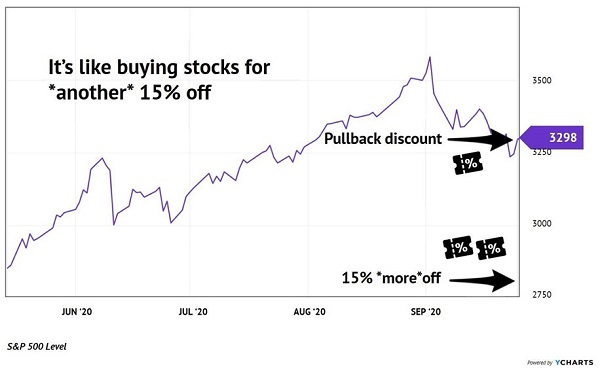Let’s take advantage of this pullback! In a moment, I’m going to outline two generous CEFs (closed-end funds) that pay 6.6%.
Thanks to last week’s market action, each fund trades at a generous 9% discount to its NAV (net asset value). In other words, each CEF trades for just 91 cents on the dollar. Great deals.
Academic “quants” would buy these funds if they could. I can recall this from the time I was scribbling furiously on my “ETF Managers Group”-sponsored notepad at the Inside Fixed Income conference in San Diego, CA. (in-person to boot, how 2019!). Full “dividend geek” mode took over and I wrote faster and faster. Your income strategist couldn’t believe his ears!
Fifteen percent per year, every year? From closed-end funds (CEFs)? With a strategy this simple?
Matisse Capital’s artful Eric Boughton was sharing his firm’s research on CEFs, the only vehicle they use to make steady returns for their clients.
As we’ve often discussed, Eric shared that when it comes to CEFs, it really is all about the discount. Our big “edge” buying these funds is our ability to pay less than face value for perfectly good assets.
In theory it makes sense, and in practice we’ve successfully employed this strategy in our Contrarian Income Report purchases. But Eric’s research (conducted with the University of Oregon’s Lundquist College of Business) backed up our bargain hunting with two big points.
First, if you’d taken the 600+ CEFs in existence since 2008, and simply bought the funds trading at discounts to their net asset values (NAVs), you’d have earned 11% per year. (This assumes you “rebalance” monthly to sell any funds that swing to premiums and reinvested the money in newly discounted funds.)
Eleven percent per year is pretty good, especially given the lack of thought required to execute on this strategy. And it gets even better. If you were pickier and bought only the most discounted “quintile,” or 20% (the 100+ funds with the biggest gaps between their prices and their NAVs), you’d have banked 15% per year!
Fifteen percent, every year, simply by being contrarian.
Of course, we can further improve upon this study by cherry-picking Eric’s target quintile. In doing so, we can set ourselves up for 20%+ total returns from safe CEFs.
Our secret? We wait for a pullback—and buy in bunches when it’s done.
CEFs tend to get dumped when the markets roll over. These are liquidity-driven vehicles that are popular with individual investors. These “weak hands” tend to sell when the storm clouds roll in, and as a result, CEFs—which have fixed quantities of shares—can actually be sold off by investors and trade at a discount to their net asset values (NAVs).
Thanks to last week’s Fed-fueled dumpster fire, high-quality CEFs today sell for just 91% of their “fair value.” Buying them after a pullback is like slapping a 9% off coupon on top of another coupon.

The last time we had an opportunity like this was last September. The broader indices had pulled back 10%. This presented a buying opportunity in some high-quality CEFs that was even better than buying the broader market.
For example, the Gabelli Dividend & Income (GDV) traded post-pullback for 15% below its NAV. Yes, the fund run by legendary investor Mario Gabelli was selling for just $0.85 on the dollar. Buying GDV there was like buying stocks for another 15% off on top of the 10% pullback:
The Double Discount: CEFs After a Pullback

In buying an excellent fund like GDV at this impressive discount, we had three ways to profit:
- First, the fund was yielding a fat 7.3%,
- Plus, it was trading at a 15% discount to its intrinsic value (NAV), and
- Its NAV was likely to increase as the market bounced back (hence the importance of buying after the pullback).
Total Returns = Current Yield + Discount Narrowing + NAV Gains

If you subscribe to our sister Contrarian Income Report service, you may have enjoyed profits from GDV. As I write we’re up 42% on the trade in just eight months.
On an annualized basis, we’re talking about 59% returns on a low-risk CEF purchase.
While GDV still trades at a nice discount to NAV, the two CEFs I alluded to earlier are my two favorites today. They are in our Dividend Swing Trader portfolio, both rated as Buys.
They pay 6.8% and 6.4% respectively. Each, again, trades at a 9% discount to its NAV. Since these are stock-focused funds, we are buying the underlying high-quality equities for 91 cents on the dollar.
All together we have a six-pack of timely dividend Buys in our DST portfolio today. This research is currently available for you to add to your subscription. (I don’t know how long my publisher will leave it open.) Learn more about my Dividend Swing Trading strategy here.
